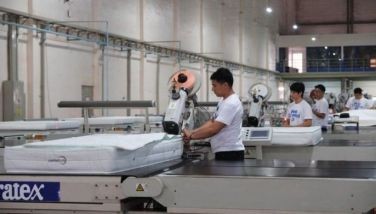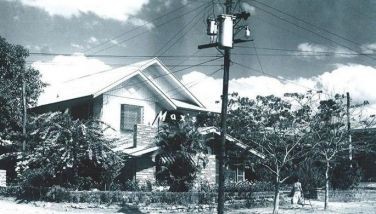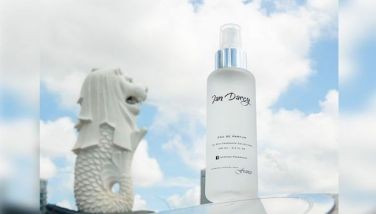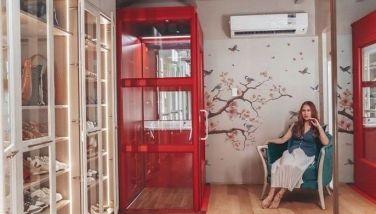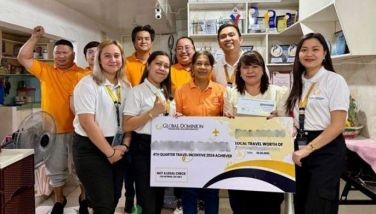Alligator in the pool
May 13, 2003 | 12:00am
Kicking off from the pool’s wall, he glides effortlessly in the water, covering meters in a second. He takes one arm out of the water to make his first stroke, then the next, and the next, all with nary a splash. His beating feet are propellers under the water, quiet but powerful. Before you know it he has reached the other end of the 25-meter pool, moving as smoothly and stealthily as any alligator. In fact, he has often been likened to a buwaya, hence the nickname.
He is 65-year-old Bana Sailani, swimming instructor of the Makati Sports Club and excellent representative of the Philippines in three Asian and two Olympic games. Now retired, he spends his time teaching non-swimmers to swim, and trains swimmers for competition.
Born in Siasi, Sulu in 1937, Bana was thrown in the water by his mother as a young child to teach him to swim. There was fear of cannons from the war hitting the shores, and one way to be saved was to go into the water. Children in this part of the country were like fish anyway, since most of the fishermen’s houses were built on stilts in the water. If a child fell in, he simply thrashed around until he could grab hold of one of the stilts.
Life was not easy for their family. His father was a fisherman and his older siblings pearl divers. While education and little luxuries were hard to come by, the family never missed three meals a day.
Bana showed early promise. His grade school principal, realizing his potential, encouraged him to train for provincial meets, where he won first place twice. He was discovered during his sixth grade by Sambiao Basanung, himself a record-setter and former Olympian, and brought to Manila in 1949 to train for the 1954 Asian Games, a 12-year-old boy in search of a better future.
He lived at the Rizal Memorial where athletes in training were quartered, training from 5 a.m. until 9 a.m., and again from 3 p.m. to 7 p.m. He lived and breathed training during these years. His studies were put on hold. He received a relatively generous allowance, for that period, of P20 per week.
Recognized for his good forearm stroke, along with his stamina, grit and determination, he set the Philippine record in freestyle, his specialty stroke, for the 1,500-meter race in March 1953, knocking five seconds off from the record set by his mentor Sambiao Basanung in the 1950 Olympiad tryouts. In December of the same year, he shattered the record for the 400-meter race, twice in a row, becoming the first Filipino to swim that distance in less than five minutes, beating Agapito Lozada, then considered his toughest competitor, by almost two meters. He was voted 1953 "Athlete of the Year" by the Philippine Sportswriters Association (PSA).
His medal harvests at the ’54, ’58 and ’62 Asian Games were bountiful with silvers and bronzes not just for himself but for the team. Bana was voted "Swimmer of the Year" by the PSA twice, in 1954 and 1958.
Like the rest of the Philippine swim team, his stints at the Olympics–Melbourne in 1956 and Rome in 1960–were disappointing, failing to make the finals in the face of competition from the best swimmers in the world. While his time of 18:18.8 in the 1,500-meter race in Rome would have been enough for the gold in the 1952 Helsinki Olympiad, it only landed him in tenth spot in Rome.
Bana did not go home to Sulu, but instead stayed in Manila to study at the University of Santo Tomas. He was almost 20 years old and only starting high school. Education was the price he paid for the country’s glory. This did not stop him from having three girlfriends, however (in sequence, not all together). It was also around this time that he was baptized, having become part of the Catholic school. He took on the name Martin, after one of the priests. He never fully converted, however, and remains a Muslim to this day.
During these years he continued to shatter his own records and set new ones in the middle and long distance categories. He was the undisputed long-distance king. While his times in the various races were common by world standards they were fantastic by local standards. In 1960 he was the holder of national records in the 400-, 800- and 1,500-meter freestyle races.
Before the Rome Olympics he had stopped studying. He decided to help his youngest and favorite brother Egging in completing his education. This was another Sailani with a chance at a good future, graduating salutatorian from high school. Bana had plans to send him to the University of the Philippines for college. He was devastated when Egging died after his high school graduation from complications of ulcer.
Throughout all the years he had been competing, he remembers Don Manolo Elizalde and Senator Ambrosio Padilla as constant and generous supporters of athletes in training. Players would be slipped a few hundred pesos (a hefty sum in those days) as reward for a job well done.
After the Asian Games he did not go back to UST. He took on odd jobs, lived with different friends, and continued to swim and train on his own. He also taught children to swim.
In 1963 he married Aurora whom he met while working for Don Manolo Elizalde. He sought dispensation to be married in the Catholic Church out of love for his wife-to-be. They have four grown children, all college graduates. His eldest, Jacqueline, manages a manpower agency, sons James and Jason are teachers here in Manila and Canada, respectively, while the youngest, Jane, is with the Philippine Air Force. He has three grandchildren from his two sons. Sadly, all his siblings have now passed away, taken by various illnesses in the province.
It was also in 1963 that he joined the Philippine Air Force, training athletes for intra-military games. He retired from the PAF in 1992. From 1975 until 1999, he concurrently taught and trained grade school students at the Ateneo, and has been teaching at the Makati Sports Club since 1978, personally instructing his students. He encourages beginners to learn to swim independently and not be afraid of the water. While he keeps a watchful eye, he refrains from literally holding the hands of his students as they learn to move in the water. He does not pressure or confuse his students with too many moves and strokes at one time. Students will learn freestyle before they move on to the backstroke, and will only be taught the breaststroke when they are comfortable with both freestyle and backstroke. He does not rush them into perfecting a stroke or to swim with great speed, but instead assures them that they will eventually get there. And they do.
A humble and down-to-earth man, I asked him why he did not put up his own school with its pool of swimming instructors. "Simple lang akong tao," he says, with a shy smile that belies his storied and medalled past, and his moves as smooth as an alligator.
He is 65-year-old Bana Sailani, swimming instructor of the Makati Sports Club and excellent representative of the Philippines in three Asian and two Olympic games. Now retired, he spends his time teaching non-swimmers to swim, and trains swimmers for competition.
Born in Siasi, Sulu in 1937, Bana was thrown in the water by his mother as a young child to teach him to swim. There was fear of cannons from the war hitting the shores, and one way to be saved was to go into the water. Children in this part of the country were like fish anyway, since most of the fishermen’s houses were built on stilts in the water. If a child fell in, he simply thrashed around until he could grab hold of one of the stilts.
Life was not easy for their family. His father was a fisherman and his older siblings pearl divers. While education and little luxuries were hard to come by, the family never missed three meals a day.
Bana showed early promise. His grade school principal, realizing his potential, encouraged him to train for provincial meets, where he won first place twice. He was discovered during his sixth grade by Sambiao Basanung, himself a record-setter and former Olympian, and brought to Manila in 1949 to train for the 1954 Asian Games, a 12-year-old boy in search of a better future.
He lived at the Rizal Memorial where athletes in training were quartered, training from 5 a.m. until 9 a.m., and again from 3 p.m. to 7 p.m. He lived and breathed training during these years. His studies were put on hold. He received a relatively generous allowance, for that period, of P20 per week.
Recognized for his good forearm stroke, along with his stamina, grit and determination, he set the Philippine record in freestyle, his specialty stroke, for the 1,500-meter race in March 1953, knocking five seconds off from the record set by his mentor Sambiao Basanung in the 1950 Olympiad tryouts. In December of the same year, he shattered the record for the 400-meter race, twice in a row, becoming the first Filipino to swim that distance in less than five minutes, beating Agapito Lozada, then considered his toughest competitor, by almost two meters. He was voted 1953 "Athlete of the Year" by the Philippine Sportswriters Association (PSA).
His medal harvests at the ’54, ’58 and ’62 Asian Games were bountiful with silvers and bronzes not just for himself but for the team. Bana was voted "Swimmer of the Year" by the PSA twice, in 1954 and 1958.
Like the rest of the Philippine swim team, his stints at the Olympics–Melbourne in 1956 and Rome in 1960–were disappointing, failing to make the finals in the face of competition from the best swimmers in the world. While his time of 18:18.8 in the 1,500-meter race in Rome would have been enough for the gold in the 1952 Helsinki Olympiad, it only landed him in tenth spot in Rome.
Bana did not go home to Sulu, but instead stayed in Manila to study at the University of Santo Tomas. He was almost 20 years old and only starting high school. Education was the price he paid for the country’s glory. This did not stop him from having three girlfriends, however (in sequence, not all together). It was also around this time that he was baptized, having become part of the Catholic school. He took on the name Martin, after one of the priests. He never fully converted, however, and remains a Muslim to this day.
During these years he continued to shatter his own records and set new ones in the middle and long distance categories. He was the undisputed long-distance king. While his times in the various races were common by world standards they were fantastic by local standards. In 1960 he was the holder of national records in the 400-, 800- and 1,500-meter freestyle races.
Before the Rome Olympics he had stopped studying. He decided to help his youngest and favorite brother Egging in completing his education. This was another Sailani with a chance at a good future, graduating salutatorian from high school. Bana had plans to send him to the University of the Philippines for college. He was devastated when Egging died after his high school graduation from complications of ulcer.
Throughout all the years he had been competing, he remembers Don Manolo Elizalde and Senator Ambrosio Padilla as constant and generous supporters of athletes in training. Players would be slipped a few hundred pesos (a hefty sum in those days) as reward for a job well done.
After the Asian Games he did not go back to UST. He took on odd jobs, lived with different friends, and continued to swim and train on his own. He also taught children to swim.
In 1963 he married Aurora whom he met while working for Don Manolo Elizalde. He sought dispensation to be married in the Catholic Church out of love for his wife-to-be. They have four grown children, all college graduates. His eldest, Jacqueline, manages a manpower agency, sons James and Jason are teachers here in Manila and Canada, respectively, while the youngest, Jane, is with the Philippine Air Force. He has three grandchildren from his two sons. Sadly, all his siblings have now passed away, taken by various illnesses in the province.
It was also in 1963 that he joined the Philippine Air Force, training athletes for intra-military games. He retired from the PAF in 1992. From 1975 until 1999, he concurrently taught and trained grade school students at the Ateneo, and has been teaching at the Makati Sports Club since 1978, personally instructing his students. He encourages beginners to learn to swim independently and not be afraid of the water. While he keeps a watchful eye, he refrains from literally holding the hands of his students as they learn to move in the water. He does not pressure or confuse his students with too many moves and strokes at one time. Students will learn freestyle before they move on to the backstroke, and will only be taught the breaststroke when they are comfortable with both freestyle and backstroke. He does not rush them into perfecting a stroke or to swim with great speed, but instead assures them that they will eventually get there. And they do.
A humble and down-to-earth man, I asked him why he did not put up his own school with its pool of swimming instructors. "Simple lang akong tao," he says, with a shy smile that belies his storied and medalled past, and his moves as smooth as an alligator.
BrandSpace Articles
<
>
- Latest
- Trending
Trending
Latest







